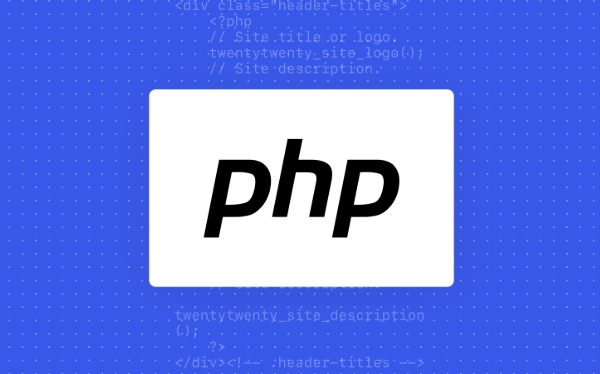 Backend Development
Backend Development
 PHP Tutorial
PHP Tutorial
 Robust Form Processing: Error Handling and User Feedback with $_POST
Robust Form Processing: Error Handling and User Feedback with $_POST
Robust Form Processing: Error Handling and User Feedback with $_POST
Always verify and clean $_POST input, use trim, filter_input, and htmlspecialchars to ensure the data is legal and secure; 2. Provide clear user feedback, display error messages or success prompts by checking the $errors array; 3. Prevent common vulnerabilities, use session tokens to prevent CSRF attacks, avoid unescaped output and SQL injection; 4. Keep valid inputs submitted by the user when an error occurs, improving the user experience. Follow these steps to build a secure, reliable PHP form processing system that ensures data integrity and user-friendliness.

Handling form submissions securely and effectively in PHP requires more than just reading data from $_POST . A robust form processing system must include proper error handling, data validation, and clear user feedback. Here's how to build a reliable form processor using $_POST with attention to these key aspects.

Validate and Sanitize Input from $_POST
Never trust user input. Always validate and sanitize data from $_POST before using it.
- Validation ensures the data meets expected criteria (eg, email format, required fields).
- Sanitization cleans the data to remove or escape potentially harmonious content.
$errors = [];
$data = [];
// Check if form was submitted
if ($_SERVER['REQUEST_METHOD'] === 'POST') {
// Trim and sanitize input
$name = trim($_POST['name'] ?? '');
$email = filter_input(INPUT_POST, 'email', FILTER_VALIDATE_EMAIL);
$message = trim($_POST['message'] ?? '');
// Validate required fields
if (empty($name)) {
$errors[] = 'Name is required.';
} else {
$data['name'] = htmlspecialchars($name, ENT_QUOTES, 'UTF-8');
}
if (!$email) {
$errors[] = 'A valid email is required.';
} else {
$data['email'] = $email; // filter_input already sanitizes
}
if (empty($message)) {
$errors[] = 'Message is required.';
} else {
$data['message'] = htmlspecialchars($message, ENT_QUOTES, 'UTF-8');
}
// If no errors, process the form (eg, save to DB, send email)
if (empty($errors)) {
// Process valid data
$success = true;
// Example: mail($data['email'], 'Feedback', $data['message']);
}
}Provide Clear User Feedback
After processing, show users what happened—whether success or errors.

Use a simple conditional to display messages:
<?php if (!empty($errors)): ?>
<div class="error">
<ul>
<?php foreach ($errors as $error): ?>
<li><?= htmlspecialchars($error) ?></li>
<?php endforeach; ?>
</ul>
</div>
<?php endif; ?>
<?php if (isset($success)): ?>
<div class="success">
Thank you! Your message has been sent.
</div>
<?php endif; ?>This keeps the user informed and improves UX by highlighting issues.

Protect Against Common Vulnerabilities
Even with $_POST , your form can be exploited without precautions.
Check for CSRF (Cross-Site Request Forgery) by using tokens:
// On form display session_start(); $_SESSION['token'] = bin2hex(random_bytes(32)); // In form // <input type="hidden" name="token" value="<?= $_SESSION['token'] ?>"> // On submission if (!hash_equals($_SESSION['token'], $_POST['token'] ?? '')) { $errors[] = 'Invalid form submission.'; }Avoid direct output of
$_POSTwithout escaping (usehtmlspecialchars).Never use
$_POSTdata in SQL queries without prepared statements to prevent SQL injection.
Preserve User Input on Error (Optional but Helpful)
To improve usability, repopulate the form with valid data when errors occur.
<input type="text" name="name" value="<?= $data['name'] ?? '' ?>"> <textarea name="message"><?= $data['message'] ?? '' ?></textarea> <input type="email" name="email" value="<?= $data['email'] ?? '' ?>">
This avoids making users re-enter everything after a typo.
Robust form processing with $_POST comes down to validating input, handling errors gracefully, giving feedback, and protecting against attacks. Do these consistently, and your forms will be both secure and user-friendly.
The above is the detailed content of Robust Form Processing: Error Handling and User Feedback with $_POST. For more information, please follow other related articles on the PHP Chinese website!

Hot AI Tools

Undress AI Tool
Undress images for free

Undresser.AI Undress
AI-powered app for creating realistic nude photos

AI Clothes Remover
Online AI tool for removing clothes from photos.

Clothoff.io
AI clothes remover

Video Face Swap
Swap faces in any video effortlessly with our completely free AI face swap tool!

Hot Article

Hot Tools

Notepad++7.3.1
Easy-to-use and free code editor

SublimeText3 Chinese version
Chinese version, very easy to use

Zend Studio 13.0.1
Powerful PHP integrated development environment

Dreamweaver CS6
Visual web development tools

SublimeText3 Mac version
God-level code editing software (SublimeText3)
 Beyond `isset()`: A Deep Dive into Validating and Sanitizing $_POST Arrays
Aug 02, 2025 pm 04:36 PM
Beyond `isset()`: A Deep Dive into Validating and Sanitizing $_POST Arrays
Aug 02, 2025 pm 04:36 PM
isset()aloneisinsufficientforsecurePHPformhandlingbecauseitonlychecksexistence,notdatatype,format,orsafety;2.Alwaysvalidateinputusingfilter_input()orfilter_var()withappropriatefilterslikeFILTER_VALIDATE_EMAILtoensurecorrectformat;3.Useempty()tocheckf
 Robust Form Processing: Error Handling and User Feedback with $_POST
Aug 02, 2025 pm 04:29 PM
Robust Form Processing: Error Handling and User Feedback with $_POST
Aug 02, 2025 pm 04:29 PM
Always verify and clean $_POST input, use trim, filter_input and htmlspecialchars to ensure the data is legal and secure; 2. Provide clear user feedback, display error messages or success prompts by checking the $errors array; 3. Prevent common vulnerabilities, use session tokens to prevent CSRF attacks, avoid unescaped output and SQL injection; 4. Retain valid inputs submitted by the user when an error occurs to improve the user experience. Follow these steps to build a safe and reliable PHP form processing system that ensures data integrity and user-friendliness.
 Troubleshooting Large Data Submissions: Understanding `post_max_size` and Its Impact on $_POST
Aug 02, 2025 pm 04:16 PM
Troubleshooting Large Data Submissions: Understanding `post_max_size` and Its Impact on $_POST
Aug 02, 2025 pm 04:16 PM
If the $_POST data disappears in PHP, the first thing to do is to check the post_max_size configuration; this setting defines the maximum amount of POST requests acceptable by PHP. If it exceeds it, $_POST and $_FILES will be empty and there is no default error prompt. It can be detected by checking that REQUEST_METHOD is POST and $_POST is empty and combined with CONTENT_LENGTH and post_max_size; it is common in a large number of input fields, hidden JSON, Base64 pictures or multiple file upload scenarios; the solution includes increasing post_max_size (such as set to 32M) in php.ini, while ensuring upload_ma
 The Synergy of $_POST and $_FILES: Managing Form Fields Alongside File Uploads
Aug 06, 2025 am 06:38 AM
The Synergy of $_POST and $_FILES: Managing Form Fields Alongside File Uploads
Aug 06, 2025 am 06:38 AM
To process file upload and form data at the same time, you must use the POST method and set enctype="multipart/form-data"; 1. Make sure that the HTML form contains method="post" and enctype="multipart/form-data"; 2. Get text fields such as title and description through $_POST; 3. Access the detailed information of uploaded files through $_FILES; 4. Check $_FILES['field']['error'] to ensure that the upload is successful; 5. Verify the file size and type to prevent illegal uploading; 6. Use m
 Implementing CSRF Tokens to Secure Your $_POST Requests Against Forgery
Aug 04, 2025 am 09:13 AM
Implementing CSRF Tokens to Secure Your $_POST Requests Against Forgery
Aug 04, 2025 am 09:13 AM
Generate and store secure CSRF tokens: use random_bytes() to generate encrypted secure tokens and deposit $_SESSION at the beginning of the session; 2. Insert the token as a hidden field into the form and output through htmlspecialchars() to prevent XSS; 3. Use hash_equals() in the processing script to verify whether the submitted token is consistent with the token stored in the session, and if the verification fails, it will return a 403 error; 4. The token should be invalidated and regenerated after sensitive operations; 5. Always transmit via HTTPS, avoid exposing the token in the URL, and do not use GET for state changes, and combine SameSite=Strict or Lax session cookies
 Leveraging $_POST for Resource Creation in a RESTful PHP API
Aug 04, 2025 am 04:24 AM
Leveraging $_POST for Resource Creation in a RESTful PHP API
Aug 04, 2025 am 04:24 AM
TobuildarobustRESTfulPHPAPI,donotrelysolelyon$_POST,asitonlypopulateswithform-encodeddataandnotJSON;2.ChecktheContent-TypeheadertodetermineiftheinputisJSON,thenreadphp://inputanddecodeitusingjson_decode;3.IfthecontenttypeisnotJSON,fallbackto$_POSTfor
 Debugging Empty $_POST Arrays: Common Pitfalls and Solutions
Aug 03, 2025 pm 02:57 PM
Debugging Empty $_POST Arrays: Common Pitfalls and Solutions
Aug 03, 2025 pm 02:57 PM
Themostcommoncauseofanempty$\_POSTarrayisanincorrectContent-Typeheader,suchasusingapplication/jsoninsteadofapplication/x-www-form-urlencodedormultipart/form-data,whichpreventsPHPfromparsingthedatainto$\_POST;usephp://inputtoreadJSONorcorrecttheConten
 A Modern Approach to Sanitization: Using `filter_input` with INPUT_POST
Aug 08, 2025 pm 06:33 PM
A Modern Approach to Sanitization: Using `filter_input` with INPUT_POST
Aug 08, 2025 pm 06:33 PM
Use filter_input function to process POST input in PHP, because it can simultaneously implement secure access and filter verification, avoiding the risks of XSS and SQL injection caused by direct use of $_POST; 1. Use FILTER_SANITIZE_FULL_SPECIAL_CHARS to replace the deprecated FILTER_SANITIZE_STRING for special character escape; 2. Use FILTER_VALIDATE_EMAIL and FILTER_VALIDATE_INT to ensure the correct data format; 3. Arrays or multiple fields can be batch processed through encapsulation functions; 4. Pay attention to starting from PHP8.1






